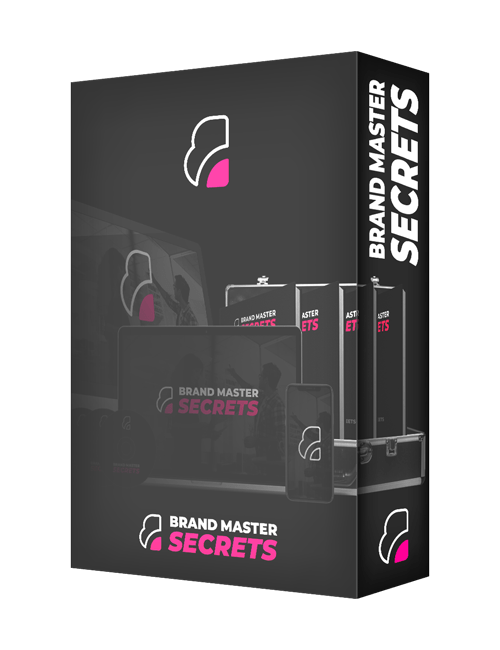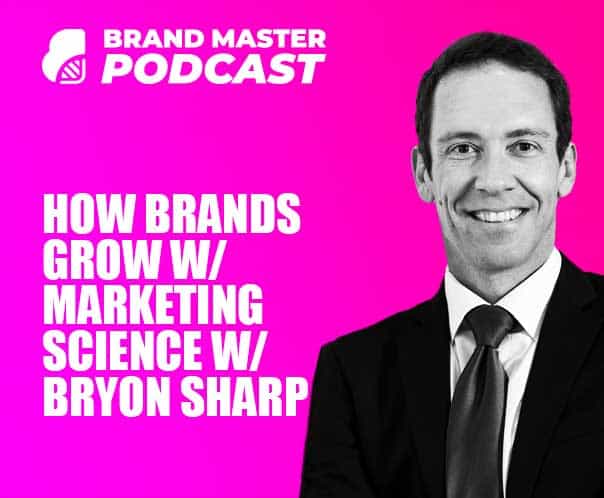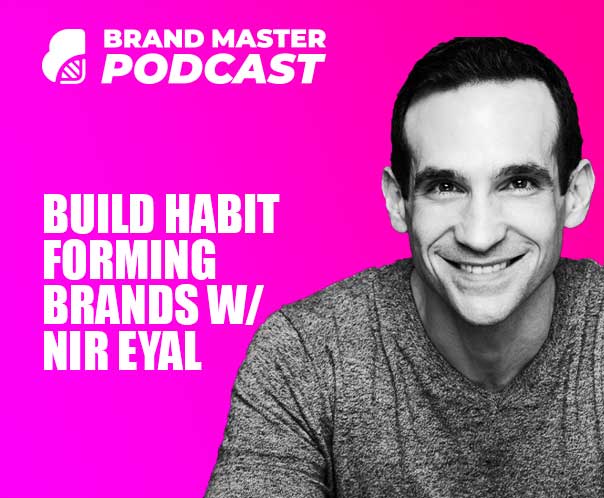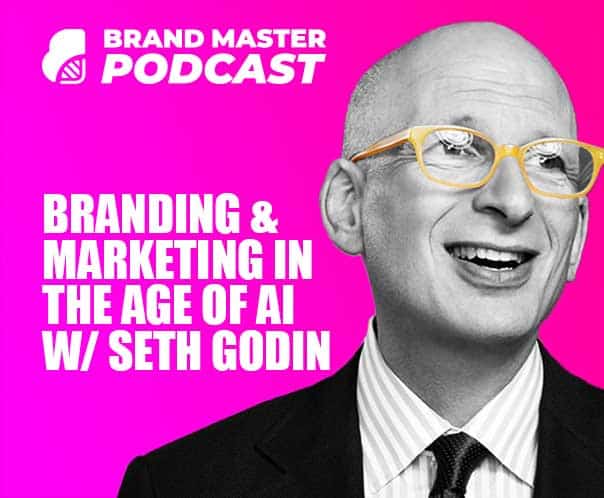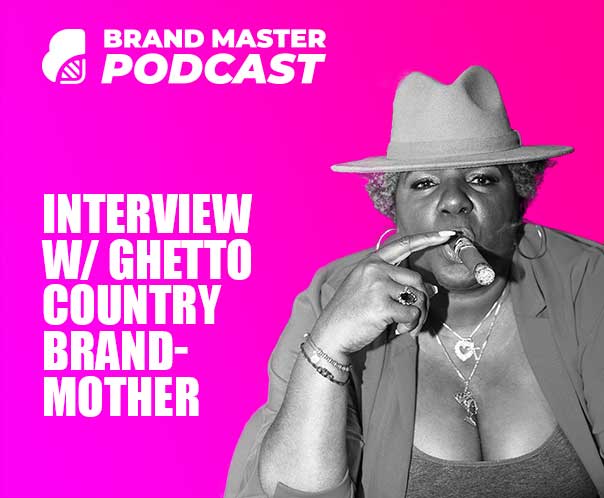In this article, I’m joined by the one and only Michael Janda. He’s an agency veteran and havet built a solid 20 person strong agency with the who’s who of clients from Google to Disney, to Netflix, and many, many more household name brands.
He’s also a business coach and the bestselling author of Burn Your Portfolio and just a genuine all-round nice guy today. He shares his vast experience on how to increase your prices, get bigger clients and grow your agency.
So if you want to learn the principles of pricing, The core pricing structures and how to upsell your clients to strategy, then stick around for this episode of the Brand Master Podcast.
Junior Designer To Art Director (Michael Janda)

Stephen Houraghan
I love your story and where you’ve come from because I listened to a podcast a while ago, I can’t remember which podcast it was on, but you were telling them about your humble beginnings.
You had that job as a starting off. The one that you kinda didn’t want to take, you took it because you couldn’t get your foot in the door at an agency, but it was designing business cards at a print house. And then, you rise from there, it is astronomical.
Can you talk us through those humble beginnings and how you were kind of feeling at the start of your career and how you rose so quickly and got to where you got?

Michael Janda (Summarized)
It was a blow to my self-esteem, I graduated from University and I’m submitting my portfolio to agency after agency trying to land somewhere and thinking that I would be able to cause, you know, you had my degree and it was getting no traction.
And finally, after it was like two months of job hunting, I got my first job offer and it was at a coffee store.
That was the prepress coordinator, was my title. And I think that for somebody like me, where I’m driven so much by my own competitive nature like I don’t want to settle for mediocrity in my life.
And so when I couldn’t get a job of anything of stature and all I could get was this copy store job. It just fueled me for years to go and try and
Prove to myself and my competitive nature of proving to everyone else in the world that I was better than that first job that I got.
So I just again self-educated, it was the late nineties. I started learning HTML and flash when it came out and I’d spent $2,000 on my first little computer and just on a credit card. We

had no money, my wife and I, she was still finishing school, but I needed the tool to be able to practice and so I just got after it.
Then within four years later. I was a creative director at Fox studios, living in Los Angeles, managing a team of 50 people and. It came,
I think more out of not so much my ability to design, but my ability to lead people to speak confidently, to lead a room, to organize a team, to complete a task, all of those kinds of things, to mentor and shape other designers to provide what we needed.
That’s where I think a lot of my success came from, not so much that Mike Janda was the greatest designer in all the world. I sometimes think I’m like one of the most successful mediocre designers that ever lived because I get it and I’m good enough, but I’m not like some of the design superstars that are out there.
3 Principles Of Pricing Your Work

Stephen Houraghan
What I hear you speak about a lot and because you have the chops, you have the experience, you’ve been there and done that is in around the principles of pricing, your work and working with clients and doing it in a way that’s systemic and it’s not, you know, pulling numbers out of thin air.
Talk to me about your main principles of pricing, your work?

Michael Janda (summarised)
So I kind of reverse-engineered how I started thinking about it. When I started trying to write a book about How Do I Price This Stuff? And I had priced my agency over that of my agency run, we did over $30 million in revenue.
So that’s a ton of pricing engagements and then to do it at a sizable profit margin, you have to really understand what you’re doing. To be able to do it. And so I had a chapter in Burn Your Portfolio that I wrote back in 2012 and 2013, that was called the Fixed Bid Pricing Dart Board and it came out of the idea that
We throw a dart at the board and then we choose a price based on where that dart hits.
But if we dissect the board into three strategies that we’re going to understand, then we have a lot better chance of hitting a number that’s actually gonna work for us. So it’s not just any number from zero to 1 million.
It’s actually a set of numbers that are strategically calculated and then we throw the dart and decide where we want to have that be.
So anyway, to answer your question, three variables that we look at variable,
#1. Production Cost

How much does it cost us to produce the work?
So you got to understand how many hours you’re going to put into it and what your cost is per hour. How much do you need to earn per hour to keep the lights on in your business and in your life? So you understand that that’s variable #1.
#2. Market Value

What do other people like me charge for this same thing?
Now the like me is really important because people like me are other people in my phase, other agency owners and staff. When my agency had 20 employees, I would look around and say, okay, well, other agencies like us are charging $200,000 for this thing.
But a freelancer working out of their house, living in a middle-tier market or country is charging 20 grand for the same thing. But in my agency, it wasn’t, I couldn’t compete with the 20 grand. And that freelancer can’t charge 200 grand because they’re not bidding on it from an agency standpoint.
So market value is dependent upon people like you, what are other people like you charging?
So that’s variable number two that we have.
#3. Client’s Budget

What does this client even want to spend to solve the problem that they’re coming to me with?
Do they need a new website? We’ve determined that. That’s the thing that they actually need. Now, how much do they have allocated to that?
We take those three variables, production costs, market value, and client budget. And then we decide, where are we going to price this project somewhere in the vicinity of the ranges of those three variables.
When we’re busy with tons of work, we’re going to bid things on the high end because our price or our hourly time is at a premium.
And when we have no work we’re going to bid things on the low end to increase our chances of landing the project.
So there are a lot of different things that we take into consideration when we’re pricing.
PRO Brand Strategy BluePrint
Build Brands Like A Pro Brand Strategist
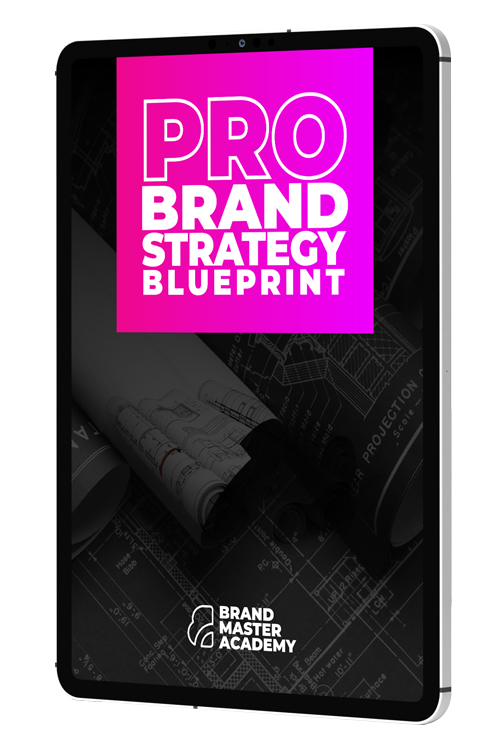
Pricing Structures: Hourly vs Fixed Cost vs Value Based Pricing

Stephen Houraghan
Businesses are all about systems. Now there is no right or wrong way to do this, but you definitely need a system. And three of the most common pricing structures that we see time, and again are hourly, fixed cost and then value-based.
I’m sure you’ve read the book The Win Without Pitching Manifesto by Blair Enns and there’s, there’s a lot of talk in the future about value based pricing.
Talk to me about your philosophy on pricing structures and what you think of value based pricing versus hourly or fixed costs?

Michael Janda (Summarised)
Here is how I compare each of these 3 pricing structures.
Hourly Cost

Hourly pricing is that it penalizes you for being really good at what you do.
You’ve been doing this a long time. You’re fast, you’re talented. You can get to the solution super fast and you know, all your keystrokes and production secrets to speed up your work and you invested in the fastest machine you can get.
Now you charge less as a result of it. You have a lot of logo designers and brand designers that follow your content based on your titling, you can design a logo in an hour, and if you’re super good. You can get to the right solution in a short amount of time.
And now you can only charge the client a small amount of money because you are so good at what you do. So hourly just sucks for that reason.
Now, when we charge by the hour, if we genuinely cannot scope this project, then maybe you go into an hourly position because you want to protect your downside on that. So there are, there are circumstances when you can charge hourly and it’s the right pricing structure.
Fixed Value

So fixed bid pricing for most circumstances, this is the most profitable way that you can do work because you can factor in the value that you’re producing for the client.
You can factor in the market value, what other people are charging for that same thing.
It rewards you for working quickly. The faster you work, the more money you make, the faster you get to the solution, the more money you make based on an hourly, based on your time.
So it is a great way to price your work and you can have a much higher profit margin based on a fixed price or fixed bid engagement.
This only works successfully if you have a super detailed scope, you have to detail out every single thing.
Then you gotta have a clause in there that says anything not detailed in here is considered out of scope because you’ll be battling the scope with clients sometimes as they try to add new little things here and there, and that’s where you can die in a fixed bid engagement.
If you say yes to the little ad-ons, now you can’t charge for them. Now you’re making less money. So that’s one of the potential downsides to fixed bid pricing.
Value Based Pricing

I have a lot on the side of value-based pricing. I conceptually love it. You should be charging based on the value that you create for your clients.
The downside to value-based pricing is that I believe that there are a lot of designers out there trying to value-based price, their projects with clients that have no business.
Trying to do value-based pricing that have no business doing value based pricing because they’re pitching value-based pricing to a client who barely understands their own business. You say to a client, and let’s just agree that the idea behind value-based pricing is you sit with the client and this is the way that I’ve seen it be taught which I think is ineffective.

You sit with the client and you say, well, how much money do you think you’ll make on this work that we do over the next year? And you get the client to say a number to you? If everything goes right, we’ll make a hundred thousand dollars.
And then you say to the client, okay, we’ll charge you 10% of that. We’ll charge you $10,000 for this thing that we’re going to create for you. That’s just a percentage of what you’re going to make on it. So it’s a good investment for you. That’s the idea behind value based pricing, as I’ve seen it taught from a variety of YouTube videos and things like that.
The problem is that when you say that to a client, you say, how much do you think you’re going to make on this over the next year, most of your clients, because it’s true that most business owners don’t have a good handle on what their business projections even are.
Most of them have no clue how to even come up with that number. So if you want a value based price, you’ve got to have
- A very seasoned and smart entrepreneur who you’re working with, who looks at their business and projects ROI on not just the engagement with you, but everything else.
- The other thing that you need to have is a project. That’s the right type of project. You can’t value based price business card design or a brochure or a menu design for a restaurant or a sign for a store.
Explore Brand Strategy
Programs & Tools
How To Upsell Design Clients To Brand Strategy?

Stephen Houraghan
Now, a lot of the work that, you’ve come from this creative agency background, and the work that you would have done would have been predominantly creative work design work.
How much of the work that you did was strategy? And did you find that yourself upselling to clients, upselling strategy to clients just by asking deeper questions? How did that work for you?

Michael Janda (Summarised)
So how do you upsell a client on strategy? It really isn’t that complicated. The upsell comes from just asking a few questions and, and letting the client realize that they don’t know their own business.
Tell me about your target customer?
Do you have a persona defined understanding of who your target customer is?
And where we can find them?
And then if you’re working with smaller businesses, A lot of entrepreneurs will be like, no, I really, I don’t know. We kinda, you know, we have a lot of different clients. They just give you some loose answer.
Okay. And then you say, okay, all right, I understand you don’t have that pin down. That’s something we can help you with.

Now, what about your competitors? Let’s look at, do you have a market positioning map or something that outlines your competitors, strengths and weaknesses versus your strengths and weaknesses and how you’re positioned to be better than those competitors?
Can you show me something like that so we can understand your market places? And then the client will be like
Oh, we’ve been, well, we kind of have these three competitors. And I mean, this is like most clients I’ve done tons of work with tons of clients. And they’ll, they’ll give you some loose answer and you’ll sit there wondering when you start asking questions like this,
How are these people even in business, how are they doing $7 million a year?
Then I think the last one is targeting like a unique value proposition of just saying,
Hey, why should someone buy your product out of all the choices out there?
Why should they buy from you?
Can you talk to me a little bit about that
and when your client comes back and they don’t really understand their target audience, when they don’t really understand the competitive landscape and they don’t really understand their unique value proposition and you’re in prime position to upsell them strategy service.
How To Ask For Client’s Budget

Stephen Houraghan
Now when it comes to client budgets at what point do you raise that and you know, how do you go about asking for that budget?

Michael Janda (Summarised)
I have a few different steps and step number one is the qualification step where we get a new opportunity that comes across our company.
In some way, it might’ve come from a referral. It might’ve come from a repeating client. It might’ve come from some advertising marketing that we did, whatever it is.
We got this lead. I’m going to go and sit with that client. And I’m going to either on the phone, in a video conference or in person, and I’m going to qualify that person, I’m going to qualify them based on three different criteria on frameworks
Criteria number one is this client even somebody I even want to work with, and if I want to work with them,
Then I’ll proceed to qualify the number two item and that’s is this project something that I can actually succeed? Is that something we can do for them to solve this problem for them?
And then criteria number three, is, is that budget right? Do they have enough money set aside or are they willing to spend what it’s going to take to solve the problem that they’re coming to us with?
So I do all of that in this qualification conversation with the client, you start asking about them, get a little vibe on who even like each other can work together.

And start asking a lot of questions about the project and just start asking questions about that project.
And then after you’ve asked all the questions and you’ve shown genuine interest in this client and their problem, then you finish with saying something along the lines of great. I think I understand this engagement. I think I understand what you’re asking for, what you need.
What budget do you have allocated to solve this for your company? You have a budget in mind that you’re trying to work within, and then the client comes to you and then they say, they’ll either give you one of two responses.
Response. Number one is, oh yeah, we have X number of dollars. Allocated or a range and
Response number two, which is most common is, oh, we’re just getting bids, just getting bids, want to see where people come back.

And my experience says that every single client that I’ve ever sat with has a number in their head already. They have a number, they know what they want to kind of want to spend, but they do want to see what people bid it in as, and so they want a number from you.
If they come back with that response where they don’t want to tell you the number, then you’ve got a couple of different strategies that you can use to try and extract the ads from them.
So strategy number one is to just give them a range and to say, okay, well, I understand that you don’t know what you want to spend. I can tell you that the last project that we did was similar.
Another one is to use clients or competitors have you other agency
And you can sit there and say, okay, well, you know, I was just watching a video on YouTube yesterday, and it was from a designer who has done a lot of great design and they have an agency and they charge $20,000 for an identity design.
So you just gotta have that conversation. It’s part of this qualification and I don’t want anybody out there bidding projects and proposing work when they don’t have an understanding of the client’s budget, you’re just wasting your time.
How To Get Bigger Clients?

Stephen Houraghan
Now you’ve worked with Google, Disney, Netflix. How did you, Mr. Michael Janda, get your foot in the door with these businesses?

Michael Janda (Summarized)
So there, there are two ways that you can land big clients. I believe these to be the only two options.
Option number one. You have a relationship with somebody who is already there.
I built my relationships with a bunch of coworkers and those coworkers ended up going to work for my first few clients, Sony, Disney and Warner brothers.
They were my friends. I go to in and out burgers on Fridays, These were people that already trusted me. They already had worked with me and they started new jobs and that landed me new clients.
So relationships, number one, that’s the way that you’re going to be able to get in with some of these big clients.
The number two way is reputation.
You’re going to build a reputation that makes them come to you. Start the relationship, you build the relationship, you get your foot in the door, and then you over-deliver to build that reputation. That it ii how you build the reputation by getting written up in every single thing that man has one of the best reputations in the creative world right now.
The Importance Of Business Systems To Growth

Stephen Houraghan
My next question for you, which is all about systems. How important are systems to your business and for you specifically, what was the game-changing system that turned your small shop into that big agency?

Michael Janda (Summarized)
All of it came out of systems that I created for my agency to be able to replicate what I do on a qualification phone call so that I could say to my right-hand person, okay, you’re going to get on a qualification phone call. Here’s how you do it.
Ask these questions and then qualify them based on the client, the project, and the budget, and then come to me and we’ll decide if we’re going to take on the work or not and it all came out of systems.
So what was the one system?
The game-changing system that changed everything for my business is it was creating systems for every single thing that my business did, was the game-changer down to Scripts.
I share a lot of scripts in my content. I’m not rewriting those scripts for those scripts.
I like pulling out of my old agency documentation. It’s stuff that I would give to my people and say, Hey, if the client says this, then you say this, it’s scripts and checklists, and you create it for every single thing that you do so that you can replicate your behavior. Across other people that you hire and it’s a game.
How To Grow As A Freelancer

Stephen Houraghan
if there’s a freelancer listening to this right now, and they’re in that phase and they’ve, they’ve got these clients and you know, they’re putting on the sales hat and they’re putting on the design hat and they’re putting on the marketing hat.
What would you say would be if you were in their position right now, what would be the first thing that you would do to change that let’s say you wanted to rebuild riser or rebuild another agency?
What would be the first thing that you would do?

Michael Janda (Summarized)
The advice that I give people now is the advice that I wish that I would have had. You need three to six months of cashflow available to your business.
That’s your safety net. You’re your warm blankets. So you can sleep at night, but anything beyond the three to six months is subject to reinvestment and into your business.
Go hire seven people and build this as a business, because look at all this cashflow you have, and you have the money to risk on this reinvestment, into your business.
If you’ve got money or cashflow beyond that, and re-invest it, go and hire some people, your worst case scenario is in three months, you have no work and you have to let them go.
And you spent your, your safety net, well, big deal. You can build your safety net back up again, and you can let that employee go. If you have to.
The likelihood of that is very low. Most people when they get the increased overhead, it sparks and increases motivation to grind and find work and, and it changes the perception of the client.
In the client’s vision of your business, they start looking at you saying, whoa, they’re growing. And then you can start charging more because you’re growing, you’re a bigger agency.
So the clients say yes to bigger budgets because of that, they start giving you bigger projects because of it. So most of the time hiring people as a catalyst to growth as much as it is a reaction to growth.
Get In Touch With Michael Janda

Stephen Houraghan
This has been an absolute blast. There have been so many nuggets of gold right throughout this so that the listeners are going to get an absolute ton of value from this.
So thank you so much for coming on the show.
For anybody that wants to get in touch, Michael Janda wants to follow your stuff. Where’s the best place that they can get in touch?

Michael Janda (Summarized)
You know, Instagram is still my baby. That’s where I have my biggest community. So you can check me out on Instagram @morejanda on Instagram or my website: michaeljanda.com.
I have a newsletter that is sent out each week. That’s just content value content that I try and share with creative entrepreneurs.
My whole Instagram feed is filled with a bunch of value content.
Honestly, this industry has been good to me and I am grateful and I never had a mentor and I’m trying to be the mentor for as many creatives as I can find, because I had to just slave it away on a tear-soaked pillow for so many years, trying to grind it out and figure it out.
I never had anybody who was sharing with me these little secrets that can help me grow.
So I’m trying to give away every secret.
Wanna Learn More About
Brand Strategy?
On-Demand Digital Program
Brand Master Secrets
Make the transition from hired-gun to highly valued brand strategist in less than 30 days. The systems, frameworks and tools inside this comprehensive program are all you need to level up.
